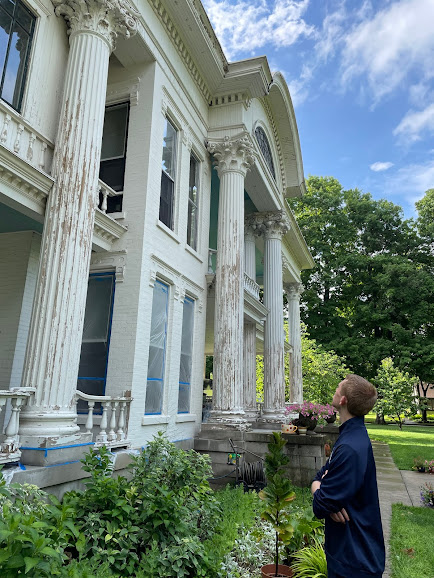That's me, up on the porch!
A couple of weeks ago, while helping my son drive his car from our home in Pennsylvania to his new job in southern California, we decided to drop in on the former home of the legendary band instrument manufacturer Charles Gerard Conn (1844-1931).
Elkhart was on our route, as we wanted to check out Chicago on our first day of driving, and I had never been to that northern Indiana town that was once hailed as "The Band Instrument Capital of the World."
Researching Elkhart before we left, I discovered that the Conn mansion still stood, having been placed on the National Register of Historic Places back in 2007:
But at some point, my son shared that he thought someone was actually in the house, so I thought we should find out! I proceeded to the front door (which is actually on the side of the mansion), ringing the bell:
Because it is a private residence, I only took a few photos inside, and only with permission, but the interior has been kept largely in the look and feel that it must have had when Conn lived there. In fact, the hanging lamp, just inside the front door, is original to the house, and created by Tiffany's of New York:
The home has five rooms on the first floor - a library, parlor, dining room, kitchen, and family room - and the second floor contains five bedrooms and two bathrooms, as well as a beautiful staircase that connects the two floors.
Lawrence Welter was hired to do the exterior remodeling at a cost of $10,000, as reported in the August 21, 1915 edition of The Elkhart Truth:
The columned two-story wrap-around porch transformed the home into a truly grand mansion (borrowing a photo this time to show it with a proper paint job!):
However, just four years later, with the Conn marriage falling apart, and Conn's wife, Catherine, experiencing poor health, the home was put on the market, as seen here in the September 27, 1919 edition of The Elkhart Daily Review:
Back to our visit, as much as the house itself was fascinating to take in, what really got me excited were the Conn artifacts that Tim and Meg have in their possession, including what they understand to be Conn's personal cornet, in its original case, from around 1885 (serial number 10608):
The cornet, which is an Ultimatum Vocal Cornet in C, Bb, and A, is beautifully engraved, with the bell reading, "Made by C. G. Conn Elkhart Ind.":
Here is the Liberati Model mouthpiece that was in the case:
Here's a closer look at the engraving in the middle ("C. G. Conn From His Employees Jan. 29, 1895"):
And speaking of engraving, Tim also brought out a full set of silverware, with every handle of every piece marked, "C. G. Conn." Here's a knife handle:
As we continued sharing what each of us knew about Conn, Tim asked if we were going to visit his grave site, since it was nearby, and I said I hadn't even thought of that! Then, upholding that midwestern hospitality once again, he offered to lead us there in his pickup truck, which is exactly what he and his wife did.
The Levy Model mouthpiece, as it turns out, is actually one of Conn's Elastic Rim Mouthpieces, which harkens back to how Conn got his start in the instrument making business.
The legendary story, for which there is no real evidence, goes that young Girard Conn, as he was known in those days, got in a fight, and ended up with a split lip. As a cornet player in the local band, that was a problem, so he created a mouthpiece with a rubber rim, to make it easier for him to play.
Whether that happened or not (and Margaret Downie Banks, an expert on Conn, has found nothing to support it), there is no argument that, by late 1874, Conn started manufacturing such mouthpieces for others. Here's the earliest notice I found about this in the October 15, 1874 edition of The Elkhart Weekly Review:
Back in the mansion, Tim also showed us a gorgeous double ink well that Conn's employees bought for him on his 51st birthday:
Our first stop was the site where the Conn factory of 1910 had once stood (the one built following the fire of that year), which is a whole lot of nothing at present. But here's what it looked like when it was first built:
And here's what it had expanded to by the 1950s:
We then proceeded to Grace Lawn Cemetery, to see who all was buried there, but I'll save that for a future post. Stay tuned!
























I love this house and I'm so glad you came to elkhart to visit! It's really cool to see my neighborhood mentioned online
ReplyDelete